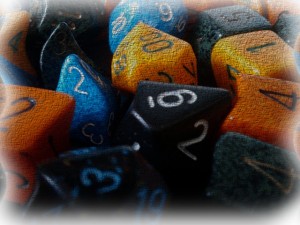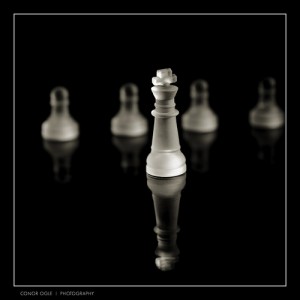 I wasn’t the best DM when I first started in the 4e world. Part of it was our setup, 5 friends in Syracuse, NY with a laptop hooked to someone’s big screen TV, me in Pittsburgh, PA in my computer room, Gametable or MapTools providing the game table and a Teamspeak server providing voice. I first started as a player in this set up, but it always felt like being a secondary citizen. When we finished Keep on the Shadowfell, everyone thought me taking the DM role would work best for a few reasons: when I spoke people would have to listen, I was the ‘creative’ one of the group, and I was the only one who wasn’t married so I would have the most free time to work on prep. (Their words, not mine)
I wasn’t the best DM when I first started in the 4e world. Part of it was our setup, 5 friends in Syracuse, NY with a laptop hooked to someone’s big screen TV, me in Pittsburgh, PA in my computer room, Gametable or MapTools providing the game table and a Teamspeak server providing voice. I first started as a player in this set up, but it always felt like being a secondary citizen. When we finished Keep on the Shadowfell, everyone thought me taking the DM role would work best for a few reasons: when I spoke people would have to listen, I was the ‘creative’ one of the group, and I was the only one who wasn’t married so I would have the most free time to work on prep. (Their words, not mine)
It seemed only fitting we go into Thunderspire Labyrinth when I took over. The first few sessions went as well as a first time 4e DM-run game can go, but things seemed to even out once we got to the Seven-Pillared Hall. The players got into a fight here, and since it was the hub town for the module (and it wasn’t a planned battle from the book, so I had to create something from scratch), I felt I couldn’t just let them off the hook easily.
As written, the mage in charge of the hall is an aloof, Chaotic Neutral type. I decided to try something different; to try and exert my influence into the module. I had also done a lot of skimming of the various 4e blogs at the time, and saw an idea for speeding up combat I wanted to try: have the players roll 5d20, and they had to use those values as their next 5 attack rolls, in any order. That seemed a bit too powerful as it was, but I liked the idea of using that as a magic item effect.
So rather the mage acting like your typical distant mage, I decided to make him sort of like Gambit. Charming and joking while still threatening, but instead of fidgeting with cards the mage would always fingering and rolling a small die in his fingers while he was talking. To magically bind the players into an agreement (“Go here and get rid of these slavers who’ve been a drag on town, and I’ll ignore the destruction caused by the fight in the center of town you were in”) he enchanted a die and gave one to each of the characters.
And thus the Die of Fate was brought into the campaign.
I tried to make a big deal of it. I got a bunch of real life 6 siders, printed up the items magic powers on heavy stock card, and handed it out to each of my players. Mechanics wise, each die has a daily power, roll 5d20, your next 5 attacks must use those values as the rolls in any order.
My players absolutely loved it. They kept their dice of fate separate from their more common, bourgeoisie polyhedrals. When they used it, they moved it in front of their player sheet, with pomp and ceremony. No one wanted to be locked into 5 attacks being below 10, so it wasn’t used in every ‘boss battle’. It was a big deal when someone decided to use it, and they would always yell when rolling 5d20 “Fate be kind tonight” or something similar.
A few more sessions in I tried something else, again based on things gleaned from 4e blogs. The paladin decided to daily-action point-daily a demon brute. When asked why he was blowing two dailies, he simply said, “It’s my calling to destroy these beasts.” Note that we had done little to no rping at this point (Again, I was new), so not even thinking, I said, “Fair enough, write down on your Die of Fate card, Demon Slayer, +2 to attack rolls against demons, ‘1d8 extra radiant damage against demons'”. Everyone, not just the paladin’s player but everyone, just grinned and were in awe.
We just finished up Thunderspire last weekend, and everyone has their own Die of Fate feat, as they call it. We’re moving on to what I call a Mass Effect 2 style of campaign, with an (air)ship full of multiple PC characters and short, delve length missions to complete, all which further the larger story arc. The story has expanded to the point where each person’s Die of Fate is the key to the ship, sort of a Star Trek comm and key for entry. It’s as much a symbol of the character as the characters’ actions.
As the players were making alternate characters to be swapped in and out, I gave them the option: your character gets a Die of Fate, or, you can create something unique that fits with your character’s background, and we’ll make a power based off of that. The only rule is the object has to be related to a game or game of chance some how.
This is also where I started DMing a second group, and to save time, I have them in the same type world, just parallel to the first group. This second group also had the option to make die of fate-like items from scratch.
 This just opened the flood gates of items, as everyone from both groups really wanted to tailor their item to their character. Here are a few examples:
This just opened the flood gates of items, as everyone from both groups really wanted to tailor their item to their character. Here are a few examples:
- * A warlock addicted to magic snuck into a wizard academy to get her fix. She found a bunch of wizards passed out around a table, on which stood a potion of wizard roulette. A game played by young wizards, quaffing the potion (which magically refills) gives a random effect. (Effects are based on a table the player created, ranging from turning into a frog for a turn to resist 5/tier for the next turn.)
* A warlord who was the top of her class. As part of training the students had to play simulations of wargames with other students to hone their skills. (Even play was battle for these students). Each game was for ante, the winner taking one of the loser’s pieces. This warlord, Ender’s Game like, never lost, and her item is a pawn from the school’s commander’s army. “A lowly pawn can often be the most dangerous.”
* An archeologist artificer on a dig found an intact Nogrock, a ball from a bloody death game played by ancient orc tribes. Passing the ball to an ally (attack versus’ that ally’s reflex) grants a +2 to the ally’s next attack if it pegs them or they catch it(hit), or, it could go wide and grant the bonus to an enemy (miss, nearest enemy gets the bonus)
* A gladiator taken out of the pits melts down his chains and creates a pendant with a favour won from his last fight. Fate decides when his next attack will bring glory or shame. (Encounter power, 10+ on a d20, the pendant gives a ‘thumbs up’ and the next attack crits on 18-20, 1-9 the pendant gives a ‘thumbs down’ and the next attack is an auto miss.
There are two things I love about these and the other items created. The first is these items helped both me and the group to get to know these characters. Most of these were created with the group all present on Skype after we had finished up an existing session early. We would bounce around the mechanical effects, other players the character’s player and the DM, then the players would try and add things in based on what they knew about their character but hadn’t gotten to put to pen yet. After these short sessions (the longest item creation took 30 minutes I think), I already had a few plot hooks in mind for these characters without a character sheet even existing.
The second is that the powers hurt as much as they help. This was never a stipulation, it’s just something that organically came up as the powers were being created. Before this, I was a bit afraid that players, if given the chance to craft an item, would want to have all sorts of good things without any repercussions. But the players seemed to enjoy the chaotic nature of their items. Maybe having shown they can handle power creation, and not start cackling and muttering about their evil plan to save the world the instant they had a taste power, I might entrust the players a bit more per Thadeous’ tip.
So, have you ever let your players create their own powers or magic items? How much impact has it had in larger campaign?
Mike Hasko .-._. psychopez
Dice of Fate image subject to creative commons attribution, taken and edited by the author.
Chess piece image, ‘Army of One’, subject to creative commons attribution, was taken off of Flickr on 8/08/2010 and is property of cmogle

I’ve recently started a campaign online that’s still in the character creation process. One of the characters is addicted to a tree sap that has painkiller properties and has hallucinogenic side effects. His backstory is that he used it once after receiving a wound when nothing else was available, and has gained a dependency on it.
There’s a couple things I worked out with him on how this will affect the game. He’s an invoker, and worships the god Erathis who is written as the author of laws.
So basically his addiction leaves him with a chance of spell failure if he’s broken the law recently to use the drug. If he uses it in battle he gains temporary hit points and he gets bloodied at 1/3 HP.
It was fun making this, he brought up penalties for him breaking the law, and after searching and finding nothing we made the system in place now.